Quantitative Evaluation of Dust and Black Carbon Column Concentration in the MERRA-2 Reanalysis Dataset Using Satellite-Based Component Retrievals
Abstract
1. Introduction
2. Data and Regions
2.1. MERRA-2 Reanalysis Product
2.2. Satellite-Measured Component Retrievals
2.3. Regions of Interest
2.3.1. Dust Desert and Downwind Dust-Dominated Regions
2.3.2. Biomass Burning BC
3. Results and Discussion
3.1. Dust Column Concentration
3.1.1. Sahara Desert
3.1.2. Bodélé Depression
3.1.3. Middle East
3.1.4. Taklamakan Desert
3.1.5. Gobi Desert
3.1.6. Eastern Tropical Atlantic
3.1.7. Sub-Sahel
3.1.8. Mediterranean Basin
3.1.9. Arabian Sea
3.1.10. Bay of Bengal
3.2. BC
3.2.1. Sub-Sahel
3.2.2. Southern Africa
3.2.3. Northeast India
3.2.4. Indo–China Peninsula
3.2.5. North China Plain
3.2.6. Northeast China and East Russia
4. Conclusions
Author Contributions
Funding
Data Availability Statement
Acknowledgments
Conflicts of Interest
References
- Zhang, J.; Reid, J.S. A decadal regional and global trend analysis of the aerosol optical depth using a data-assimilation grade over-water MODIS and Level 2 MISR aerosol products. Atmos. Chem. Phys. 2010, 10, 10949–10963. [Google Scholar] [CrossRef]
- Yoon, J.; Burrows, J.P.; Vountas, M.; Von Hoyningen-Huene, W.; Chang, D.Y.; Richter, A.; Hilboll, A. Changes in atmospheric aerosol loading retrieved from space-based measurements during the past decade. Atmos. Chem. Phys. 2014, 14, 6881–6902. [Google Scholar] [CrossRef]
- Alfaro-Contreras, R.; Zhang, J.; Reid, J.S.; Christopher, S. A study of 15-year aerosol optical thickness and direct shortwave aerosol radiative effect trends using MODIS, MISR, CALIOP and CERES. Atmos. Chem. Phys. 2017, 17, 13849–13868. [Google Scholar] [CrossRef]
- Che, H.; Gui, K.; Xia, X.; Wang, Y.; Holben, B.N.; Goloub, P.; Cuevas-Agulló, E.; Wang, H.; Zheng, Y.; Zhao, H.; et al. Large contribution of meteorological factors to inter-decadal changes in regional aerosol optical depth. Atmos. Chem. Phys. 2019, 19, 10497–10523. [Google Scholar] [CrossRef]
- Klingmüller, K.; Pozzer, A.; Metzger, S.; Stenchikov, G.L.; Lelieveld, J. Aerosol optical depth trend over the Middle East. Atmos. Chem. Phys. 2016, 16, 5063–5073. [Google Scholar] [CrossRef]
- Floutsi, A.A.; Korras-Carraca, M.B.; Matsoukas, C.; Hatzianastassiou, N.; Biskos, G. Climatology and trends of aerosol optical depth over the Mediterranean basin during the last 12 years (2002–2014) based on Collection 006 MODIS-Aqua data. Sci. Total Environ. 2016, 551–552, 292–303. [Google Scholar] [CrossRef]
- Remer, L.A.; Kleidman, R.G.; Levy, R.C.; Kaufman, Y.J.; Tanré, D.; Mattoo, S.; Martins, J.V.; Ichoku, C.; Koren, I.; Yu, H.; et al. Global aerosol climatology from the MODIS satellite sensors. J. Geophys. Res. Atmos. 2008, 113, D14S07. [Google Scholar] [CrossRef]
- Prospero, J.M.; Ginoux, P.; Torres, O.; Nicholson, S.E.; Gill, T.E. Environmental characterization of global sources of atmospheric soil dust identified with the Nimbus 7 Total Ozone Mapping Spectrometer (TOMS) absorbing aerosol product. Rev. Geophys. 2002, 40, 1–31. [Google Scholar] [CrossRef]
- Ginoux, P.; Prospero, J.M.; Gill, T.E.; Hsu, N.C.; Zhao, M. Global-scale attribution of anthropogenic and natural dust sources and their emission rates based on MODIS Deep Blue aerosol products. Rev. Geophys. 2012, 50, 1–36. [Google Scholar] [CrossRef]
- Song, Q.; Zhang, Z.; Yu, H.; Ginoux, P.; Shen, J. Global dust optical depth climatology derived from CALIOP and MODIS aerosol retrievals on decadal timescales: Regional and interannual variability. Atmos. Chem. Phys. 2021, 21, 13369–13395. [Google Scholar] [CrossRef]
- Xi, X.; Sokolik, I.N. Dust interannual variability and trend in Central Asia from 2000 to 2014 and their climatic linkages. J. Geophys. Res. Atmos. 2015, 120, 238. [Google Scholar] [CrossRef]
- Notaro, M.; Yu, Y.; Kalashnikova, O.V. Regime shift in arabian dust activity, triggered by persistent fertile crescent drought. J. Geophys. Res. 2015, 120, 10229–10249. [Google Scholar] [CrossRef]
- Lakshmi, N.B.; Babu, S.S.; Nair, V.S. Recent Regime Shifts in Mineral Dust Trends over South Asia from Long-Term CALIPSO Observations. IEEE Trans. Geosci. Remote Sens. 2019, 57, 4485–4489. [Google Scholar] [CrossRef]
- Chen, D.; Liu, Z.; Schwartz, C.S.; Cetola, J.D.; Gu, Y.; Xue, L. The impact of aerosol optical depth assimilation on aerosol forecasts and radiative effects during a wild fire event over the United States. Geosci. Model Dev. 2014, 7, 2709–2715. [Google Scholar] [CrossRef]
- Schwartz, C.S.; Liu, Z.; Lin, H.-C.; Cetola, J.D. Assimilating aerosol observations with a “hybrid” variational-ensemble data assimilation system. J. Geophys. Res. Atmos. 2014, 119, 4043–4069. [Google Scholar] [CrossRef]
- McHenry, J.N.; Vukovich, J.M.; Hsu, N.C. Development and implementation of a remote-sensing and in situ data-assimilating version of CMAQ for operational PM2.5 forecasting. Part 1: MODIS aerosol optical depth (AOD) data-assimilation design and testing. J. Air Waste Manag. Assoc. 2015, 65, 1395–1412. [Google Scholar] [CrossRef]
- Heidinger, A.K.; Foster, M.J.; Walther, A.; Zhao, X. The pathfinder atmospheres-extended avhrr climate dataset. Bull. Am. Meteorol. Soc. 2014, 95, 909–922. [Google Scholar] [CrossRef]
- Kahn, R.A.; Gaitley, B.J.; Martonchik, J.V.; Diner, D.J.; Crean, K.A.; Holben, B. Multiangle Imaging Spectroradiometer (MISR) global aerosol optical depth validation based on 2 years of coincident Aerosol Robotic Network (AERONET) observations. J. Geophys. Res. Atmos. 2005, 110, D10S04. [Google Scholar] [CrossRef]
- Holben, B.N.; Eck, T.F.; Slutsker, I.; Tanré, D.; Buis, J.P.; Setzer, A.; Vermote, E.; Reagan, J.A.; Kaufman, Y.J.; Nakajima, T.; et al. AERONET—A Federated Instrument Network and Data Archive for Aerosol Characterization. Remote Sens. Environ. 1998, 66, 1–16. [Google Scholar] [CrossRef]
- Buchard, V.; Randles, C.A.; da Silva, A.M.; Darmenov, A.; Colarco, P.R.; Govindaraju, R.; Ferrare, R.; Hair, J.; Beyersdorf, A.J.; Ziemba, L.D.; et al. The MERRA-2 aerosol reanalysis, 1980 onward. Part II: Evaluation and case studies. J. Clim. 2017, 30, 6851–6872. [Google Scholar] [CrossRef]
- Randles, C.A.; da Silva, A.M.; Buchard, V.; Colarco, P.R.; Darmenov, A.; Govindaraju, R.; Smirnov, A.; Holben, B.; Ferrare, R.; Hair, J.; et al. The MERRA-2 Aerosol Reanalysis, 1980 Onward. Part I: System Description and Data Assimilation Evaluation. J. Clim. 2017, 30, 6823–6850. [Google Scholar] [CrossRef] [PubMed]
- Buchard, V.; da Silva, A.M.; Randles, C.A.; Colarco, P.; Ferrare, R.; Hair, J.; Hostetler, C.; Tackett, J.; Winker, D. Evaluation of the surface PM2.5 in Version 1 of the NASA MERRA Aerosol Reanalysis over the United States. Atmos. Environ. 2016, 125, 100–111. [Google Scholar] [CrossRef]
- Buchard, V.; Da Silva, A.M.; Colarco, P.R.; Darmenov, A.; Randles, C.A.; Govindaraju, R.; Torres, O.; Campbell, J.; Spurr, R. Using the OMI aerosol index and absorption aerosol optical depth to evaluate the NASA MERRA Aerosol Reanalysis. Atmos. Chem. Phys. 2015, 15, 5743–5760. [Google Scholar] [CrossRef]
- Giordano, L.; Brunner, D.; Flemming, J.; Hogrefe, C.; Im, U.; Bianconi, R.; Badia, A.; Balzarini, A.; Baró, R.; Chemel, C.; et al. Assessment of the MACC reanalysis and its influence as chemical boundary conditions for regional air quality modeling in AQMEII-2. Atmos. Environ. 2015, 115, 371–388. [Google Scholar] [CrossRef]
- Bellouin, N.; Quaas, J.; Morcrette, J.J.; Boucher, O. Estimates of aerosol radiative forcing from the MACC re-analysis. Atmos. Chem. Phys. 2013, 13, 2045–2062. [Google Scholar] [CrossRef]
- Reale, O.; Lau, K.M.; Da Silva, A.; Matsui, T. Impact of assimilated and interactive aerosol on tropical cyclogenesis. Geophys. Res. Lett. 2014, 41, 3282–3288. [Google Scholar] [CrossRef]
- Inness, A.; Baier, F.; Benedetti, A.; Bouarar, I.; Chabrillat, S.; Clark, H.; Clerbaux, C.; Coheur, P.; Engelen, R.J.; Errera, Q.; et al. The MACC reanalysis: An 8 yr data set of atmospheric composition. Atmos. Chem. Phys. 2013, 13, 4073–4109. [Google Scholar] [CrossRef]
- Kinne, S.; Schulz, M.; Textor, C.; Guibert, S.; Balkanski, Y.; Bauer, S.E.; Berntsen, T.; Berglen, T.F.; Boucher, O.; Chin, M.; et al. An AeroCom initial assessment—Optical properties in aerosol component modules of global models. Atmos. Chem. Phys. 2006, 6, 1815–1834. [Google Scholar] [CrossRef]
- Textor, C.; Schulz, M.; Guibert, S.; Kinne, S.; Balkanski, Y.; Bauer, S.; Berntsen, T.; Berglen, T.; Boucher, O.; Chin, M.; et al. Analysis and quantification of the diversities of aerosol life cycles within AeroCom. Atmos. Chem. Phys. 2006, 6, 1777–1813. [Google Scholar] [CrossRef]
- Wang, Z.; Lin, L.; Xu, Y.; Che, H.; Zhang, X.; Zhang, H.; Dong, W.; Wang, C.; Gui, K.; Xie, B. Incorrect Asian aerosols affecting the attribution and projection of regional climate change in CMIP6 models. NPJ Clim. Atmos. Sci. 2021, 4, 1–8. [Google Scholar] [CrossRef]
- Paulot, F.; Paynter, D.; Ginoux, P.; Naik, V.; Horowitz, L.W. Changes in the aerosol direct radiative forcing from 2001 to 2015: Observational constraints and regional mechanisms. Atmos. Chem. Phys. 2018, 18, 13265–13281. [Google Scholar] [CrossRef]
- Rienecker, M.M.; Suarez, M.J.; Gelaro, R.; Todling, R.; Bacmeister, J.; Liu, E.; Bosilovich, M.G.; Schubert, S.D.; Takacs, L.; Kim, G.K.; et al. MERRA: NASA’s modern-era retrospective analysis for research and applications. J. Clim. 2011, 24, 3624–3648. [Google Scholar] [CrossRef]
- Molod, A.; Takacs, L.; Suarez, M.; Bacmeister, J. Development of the GEOS-5 atmospheric general circulation model: Evolution from MERRA to MERRA2. Geosci. Model Dev. 2015, 8, 1339–1356. [Google Scholar] [CrossRef]
- Wu, W.S.; Purser, R.J.; Parrish, D.F. Three-dimensional variational analysis with spatially inhomogeneous covariances. Mon. Weather Rev. 2002, 130, 2905–2916. [Google Scholar] [CrossRef]
- Gelaro, R.; McCarty, W.; Suárez, M.J.; Todling, R.; Molod, A.; Takacs, L.; Randles, C.A.; Darmenov, A.; Bosilovich, M.G.; Reichle, R.; et al. The modern-era retrospective analysis for research and applications, version 2 (MERRA-2). J. Clim. 2017, 30, 5419–5454. [Google Scholar] [CrossRef]
- Chin, M.; Ginoux, P.; Kinne, S.; Torres, O.; Holben, B.N.; Duncan, B.N.; Martin, R.V.; Logan, J.A.; Higurashi, A.; Nakajima, T. Tropospheric Aerosol Optical Thickness from the GOCART Model and Comparisons with Satellite and Sun Photometer Measurements. J. Atmos. Sci. 2002, 59, 461–483. [Google Scholar] [CrossRef]
- Colarco, P.; Da Silva, A.; Chin, M.; Diehl, T. Online simulations of global aerosol distributions in the NASA GEOS-4 model and comparisons to satellite and ground-based aerosol optical depth. J. Geophys. Res. Atmos. 2010, 115, D14207. [Google Scholar] [CrossRef]
- Tanré, D.; Bräon, F.M.; Deuzä, J.L.; Dubovik, O.; Ducos, F.; Franäois, P.; Goloub, P.; Herman, M.; Lifermann, A.; Waquet, F. Remote sensing of aerosols by using polarized, directional and spectral measurements within the A-Train: The PARASOL mission. Atmos. Meas. Tech. 2011, 4, 1383–1395. [Google Scholar] [CrossRef]
- Li, L.; Derimian, Y.; Chen, C.; Zhang, X.; Che, H.; Schuster, G.L.; Fuertes, D.; Litvinov, P.; Lapyonok, T.; Lopatin, A.; et al. Climatology of aerosol component concentrations derived from multi-angular polarimetric POLDER-3 observations using GRASP algorithm. Earth Syst. Sci. Data 2022, 14, 3439–3469. [Google Scholar]
- Li, L.; Dubovik, O.; Derimian, Y.; Schuster, G.L.; Lapyonok, T.; Litvinov, P.; Ducos, F.; Fuertes, D.; Chen, C.; Li, Z.; et al. Retrieval of aerosol components directly from satellite and ground-based measurements. Atmos. Chem. Phys. 2019, 19, 13409–13443. [Google Scholar] [CrossRef]
- Duncan, B.N.; Martin, R.V.; Staudt, A.C.; Yevich, R.; Logan, J.A. Interannual and seasonal variability of biomass burning emissions constrained by satellite observations. J. Geophys. Res. 2003, D2, 4100. [Google Scholar] [CrossRef]
- Logothetis, S.-A.; Salamalikis, V.; Gkikas, A.; Kazadzis, S.; Amiridis, V.; Kazantzidis, A. 15-Year Variability of Desert Dust Optical Depth on Global and Regional Scales. Atmos. Chem. Phys. 2021, 21, 16499–16529. [Google Scholar] [CrossRef]
- Li, L.; Che, H.; Derimian, Y.; Dubovik, O.; Schuster, G.L.; Chen, C.; Li, Q.; Wang, Y.; Guo, B.; Zhang, X. Retrievals of fine mode light-absorbing carbonaceous aerosols from POLDER/PARASOL observations over East and South Asia. Remote Sens. Environ. 2020, 247, 111913. [Google Scholar] [CrossRef]
- Choobari, O.A.; Zawar-Reza, P.; Sturman, A. The global distribution of mineral dust and its impacts on the climate system: A review. Atmos. Res. 2014, 138, 152–165. [Google Scholar] [CrossRef]
- Prospero, J.M.; Lamb, P.J. African Droughts and Dust Transport to the Caribbean: Climate Change Implications. Science 2003, 302, 1024–1027. [Google Scholar] [CrossRef]
- Prospero, J.M.; Mayol-Bracero, O.L. Understanding the transport and impact of African dust on the Caribbean Basin. Bull. Am. Meteorol. Soc. 2013, 94, 1329–1337. [Google Scholar] [CrossRef]
- Jingfeng, H.; Chidong, Z.; Prospero, J.M. African dust outbreaks: A satellite perspective of temporal and spatial variability over the tropical Atlantic Ocean. J. Geophys. Res. Atmos. 2010, 115, D05202. [Google Scholar]
- Mona, L.; Amodeo, A.; Pandolfi, M.; Pappalardo, G. Saharan dust intrusions in the Mediterranean area: Three years of Raman lidar measurements. J. Geophys. Res. Atmos. 2006, 111, D16203. [Google Scholar] [CrossRef]
- Gkikas, A.; Basart, S.; Hatzianastassiou, N.; Marinou, E.; Amiridis, V.; Kazadzis, S.; Pey, J.; Querol, X.; Jorba, O.; Gasso, S.; et al. Mediterranean intense desert dust outbreaks and their vertical structure based on remote sensing data. Atmos. Chem. Phys. 2016, 16, 8609–8642. [Google Scholar] [CrossRef]
- Pozzer, A.; De Meij, A.; Yoon, J.; Tost, H.; Georgoulias, A.K.; Astitha, M. AOD trends during 2001–2010 from observations and model simulations. Atmos. Chem. Phys. 2015, 15, 5521–5535. [Google Scholar] [CrossRef]
- Yu, Y.; Notaro, M.; Liu, Z.; Wang, F.; Alkolibi, F.; Fadda, E.; Bakhrjy, F. Climatic controls on the interannual to decadal variability in Saudi Arabian dust activity: Toward the development of a seasonal dust prediction model. J. Geophys. Res. 2015, 120, 1739–1758. [Google Scholar] [CrossRef]
- Gkikas, A.; Proestakis, E.; Amiridis, V.; Kazadzis, S.; Di Tomaso, E.; Marinou, E.; Hatzianastassiou, N.; Kok, J.F.; García-Pando, C.P. Quantification of the dust optical depth across spatiotemporal scales with the MIDAS global dataset (2003–2017). Atmos. Chem. Phys. 2022, 22, 3553–3578. [Google Scholar] [CrossRef]
- Evan, A.T.; Flamant, C.; Gaetani, M.; Guichard, F. The past, present and future of African dust. Nature 2016, 531, 493–495. [Google Scholar] [CrossRef] [PubMed]
- Pan, B.; Wang, Y.; Hu, J.; Lin, Y.; Hsieh, J.S.; Logan, T.; Feng, X.; Jiang, J.H.; Yung, Y.L.; Zhang, R. Impacts of Saharan dust on Atlantic regional climate and implications for tropical cyclones. J. Clim. 2018, 31, 7621–7644. [Google Scholar] [CrossRef]
- Xian, P.; Klotzbach, P.J.; Dunion, J.P.; Janiga, M.A.; Reid, J.S.; Colarco, P.R.; Kipling, Z. Revisiting the relationship between Atlantic dust and tropical cyclone activity using aerosol optical depth reanalyses: 2003–2018. Atmos. Chem. Phys. 2020, 20, 15357–15378. [Google Scholar] [CrossRef]
- Gläser, G.; Wernli, H.; Kerkweg, A.; Teubler, F. The transatlantic dust transport from North Africa to the Americas—Its characteristics and source regions. J. Geophys. Res. 2015, 120, 11231–11235. [Google Scholar] [CrossRef]
- Prospero, J.M.; Collard, F.-X.; Molinié, J.; Jeannot, A. Characterizing the annual cycle of African dust transport to the Caribbean Basin and South America and its impact on the environment and air quality. Global Biogeochem. Cycles 2014, 28, 757–773. [Google Scholar] [CrossRef]
- Washington, R.; Todd, M.C.; Engelstaedter, S.; Mbainayel, S.; Mitchell, F. Dust and the low-level circulation over the Bodélé Depression, Chad: Observations from BoDEx 2005. J. Geophys. Res. Atmos. 2006, 111, D03201. [Google Scholar] [CrossRef]
- Gkikas, A.; Hatzianastassiou, N.; Mihalopoulos, N.; Katsoulis, V.; Kazadzis, S.; Pey, J.; Querol, X.; Torres, O. The regime of intense desert dust episodes in the Mediterranean based on contemporary satellite observations and ground measurements. Atmos. Chem. Phys. 2013, 13, 12135–12154. [Google Scholar] [CrossRef]
- Gkikas, A.; Houssos, E.E.; Lolis, C.J.; Bartzokas, A.; Mihalopoulos, N.; Hatzianastassiou, N. Atmospheric circulation evolution related to desert-dust episodes over the Mediterranean. Q. J. R. Meteorol. Soc. 2015, 141, 1634–1645. [Google Scholar] [CrossRef]
- Shi, L.; Zhang, J.; Yao, F.; Zhang, D.; Guo, H. Drivers to dust emissions over dust belt from 1980 to 2018 and their variation in two global warming phases. Sci. Total Environ. 2021, 767, 144860. [Google Scholar] [CrossRef] [PubMed]
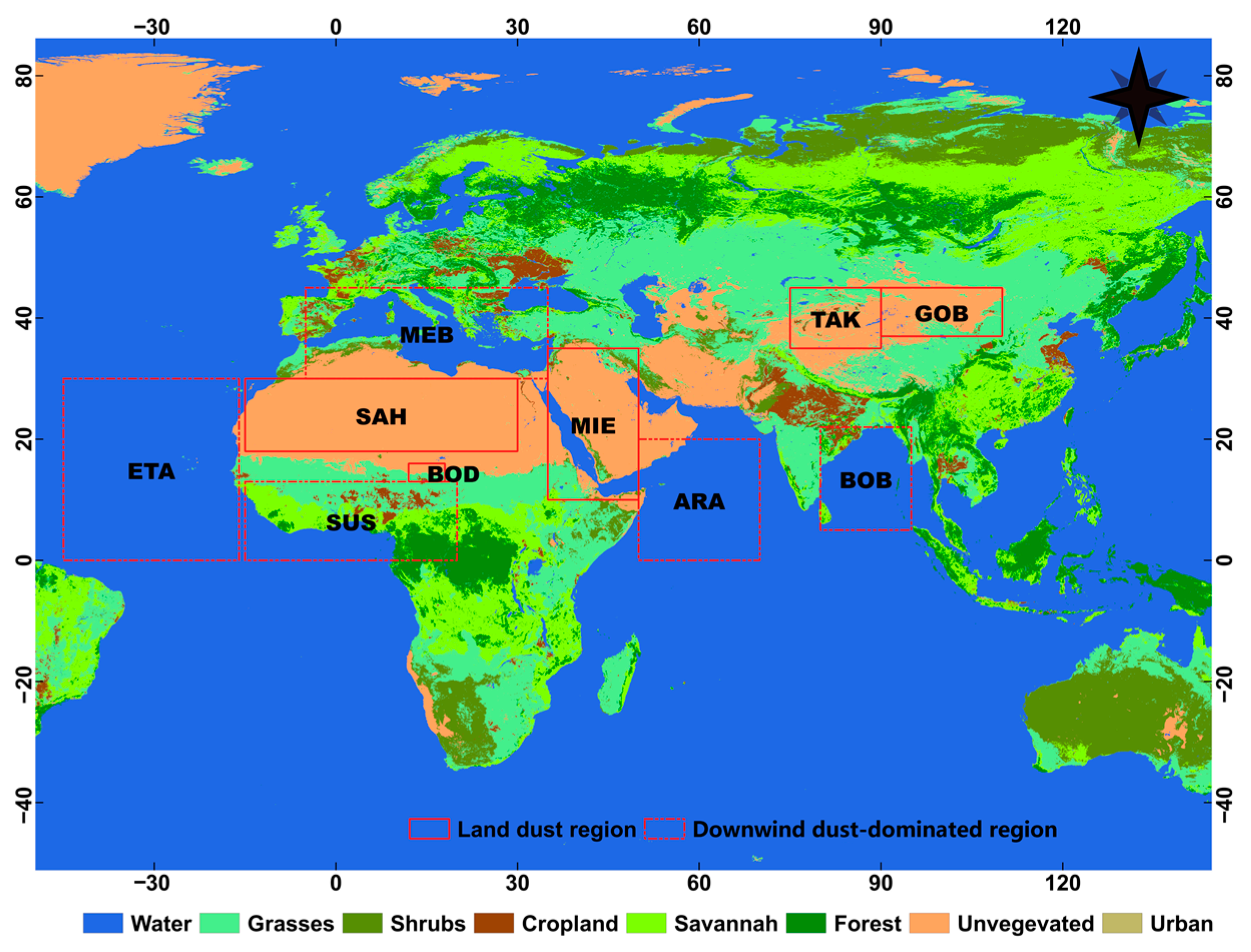
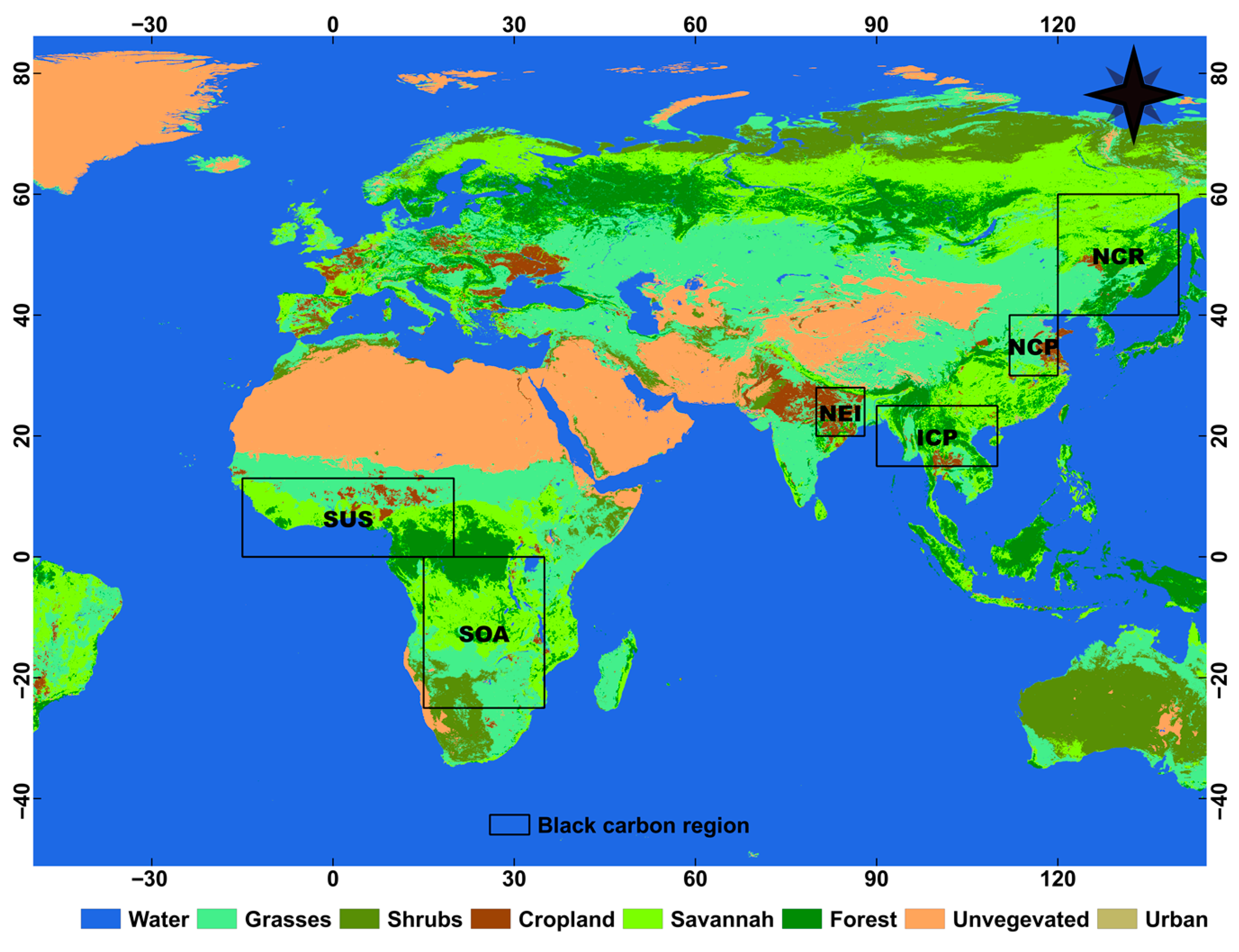
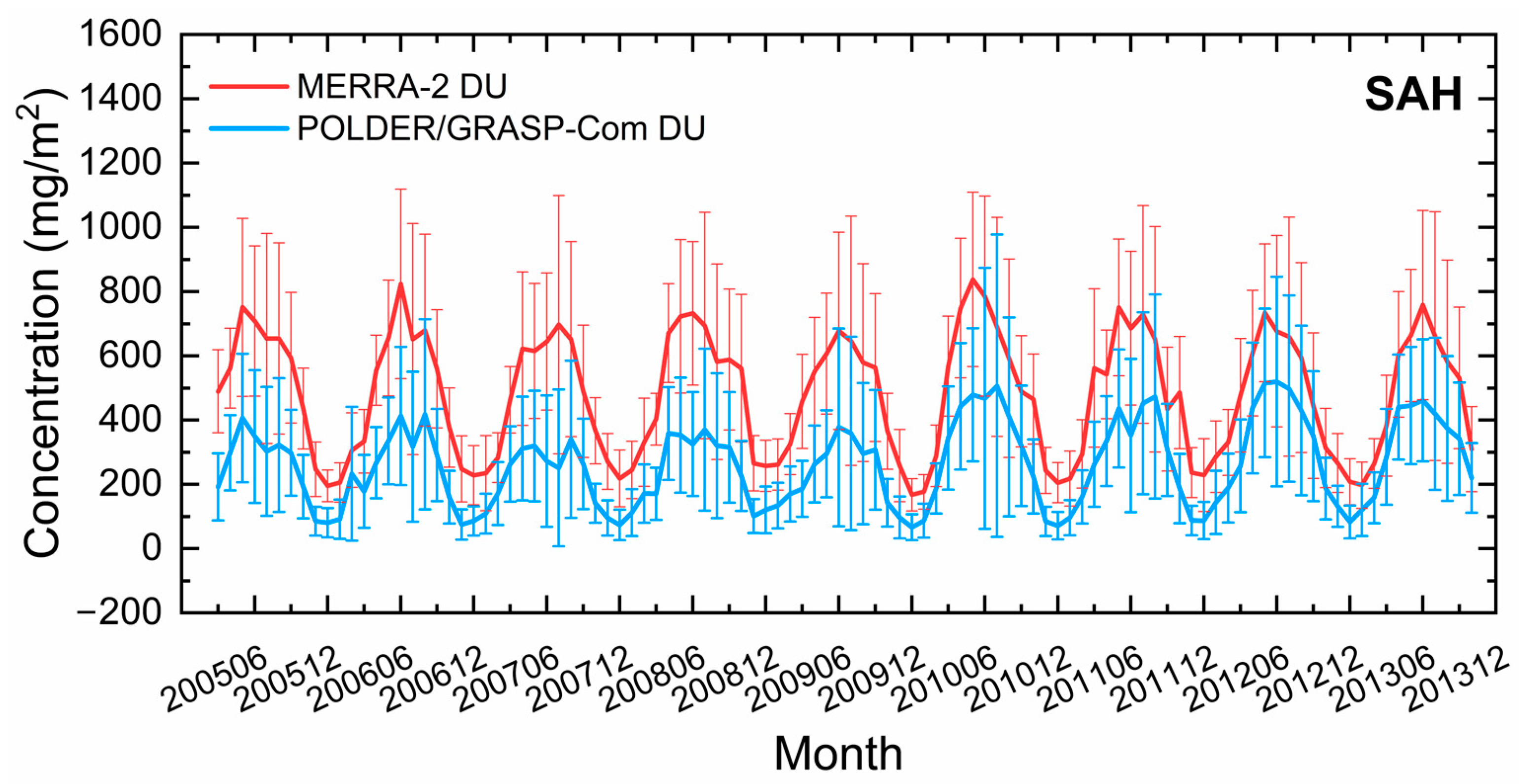
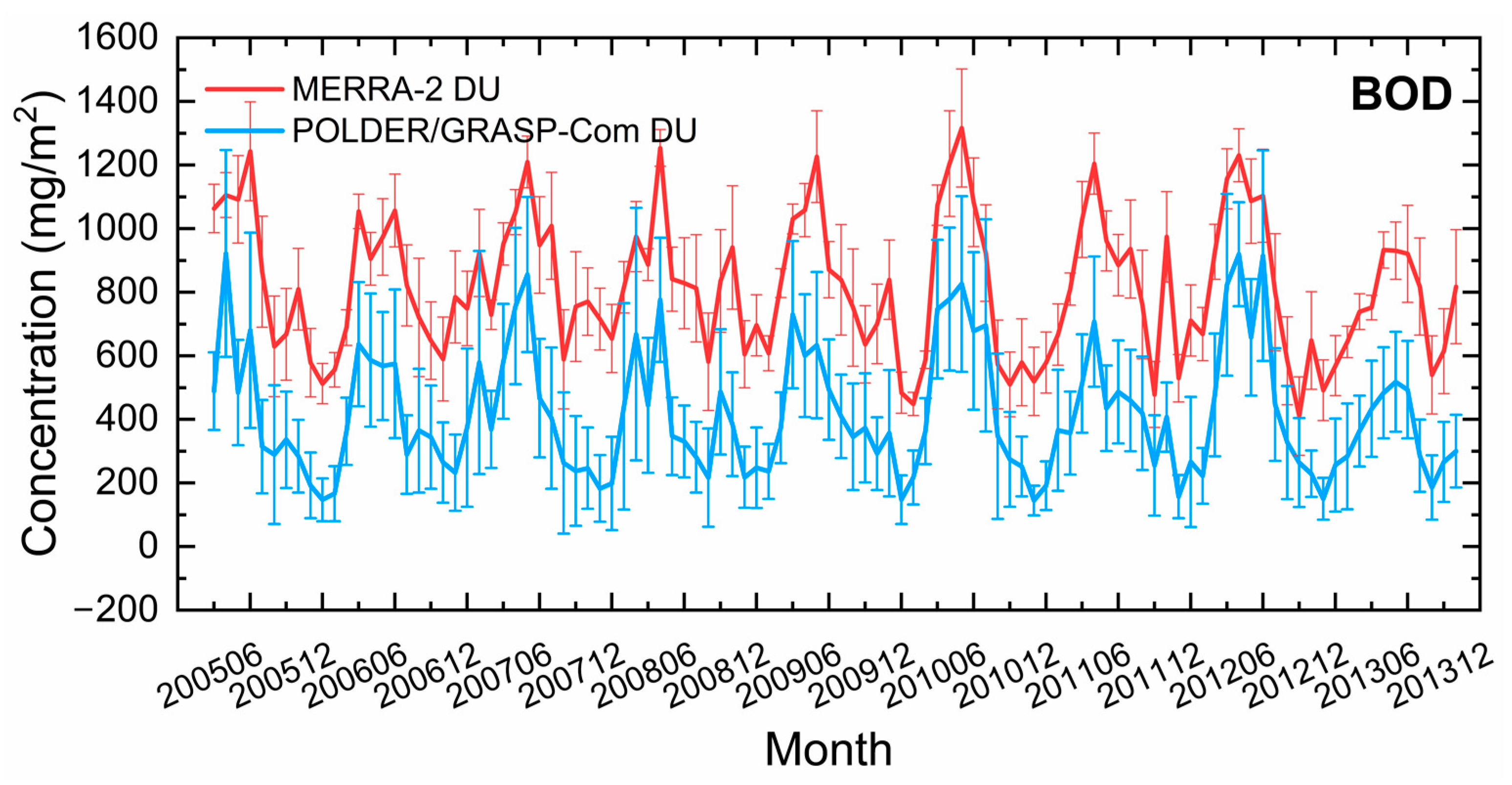
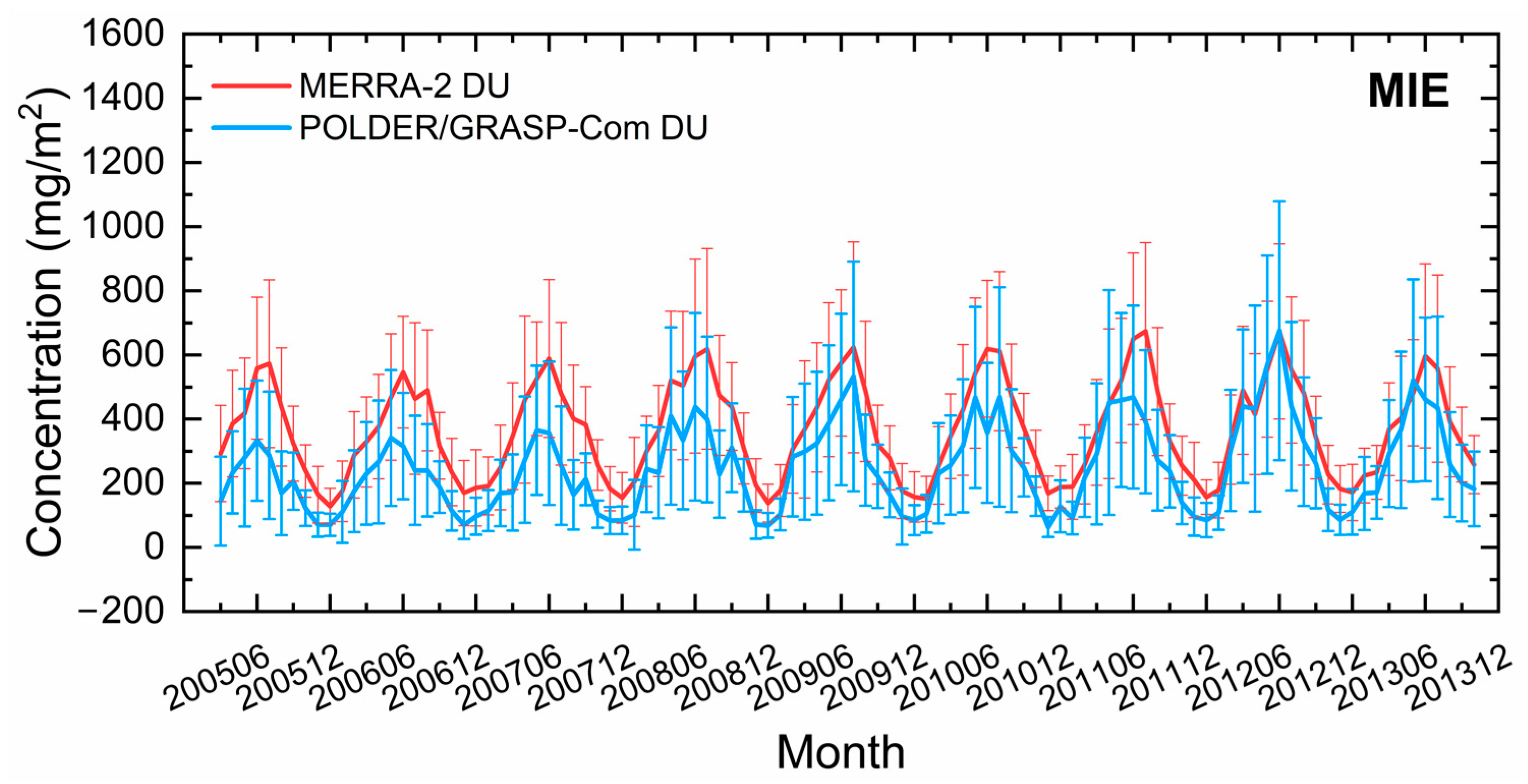
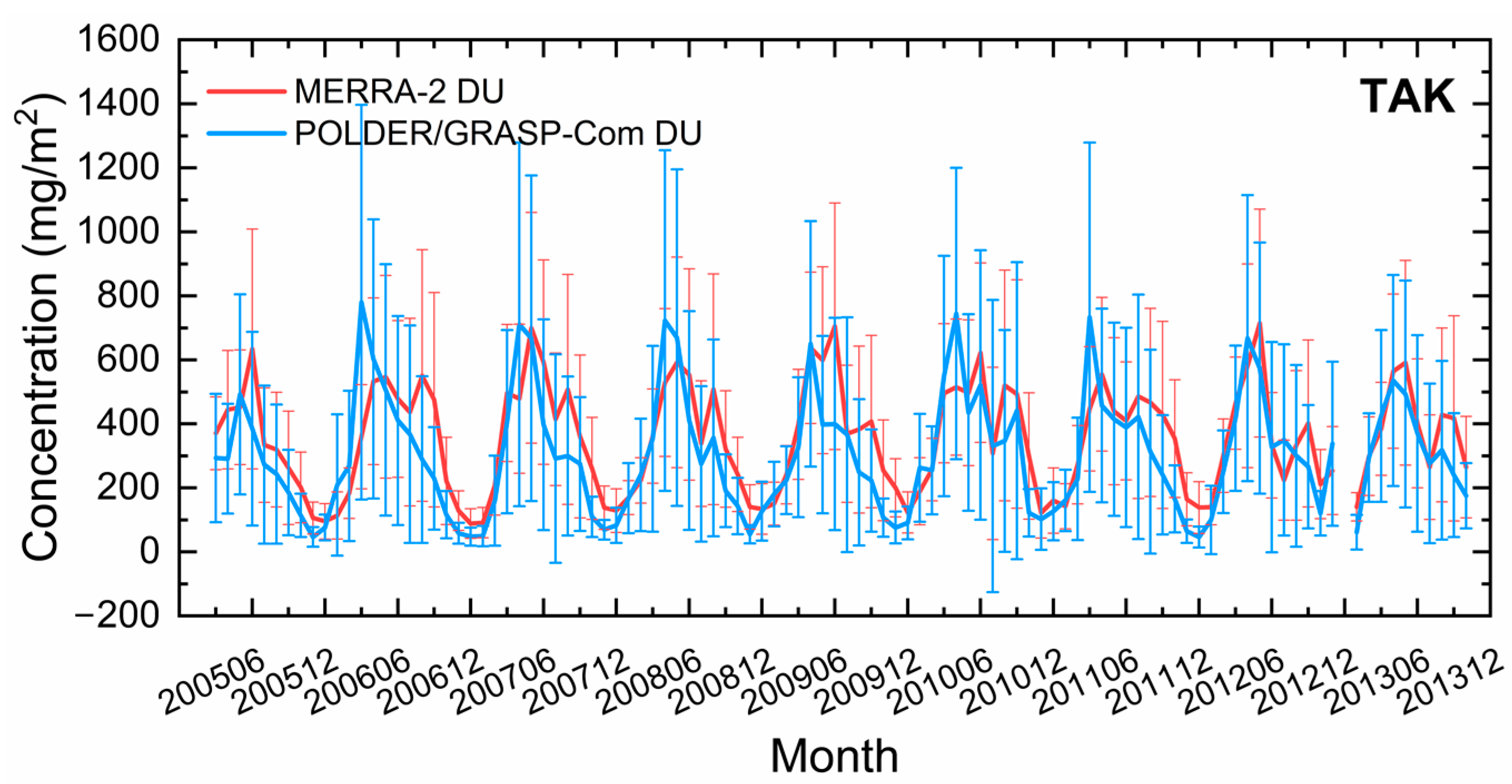
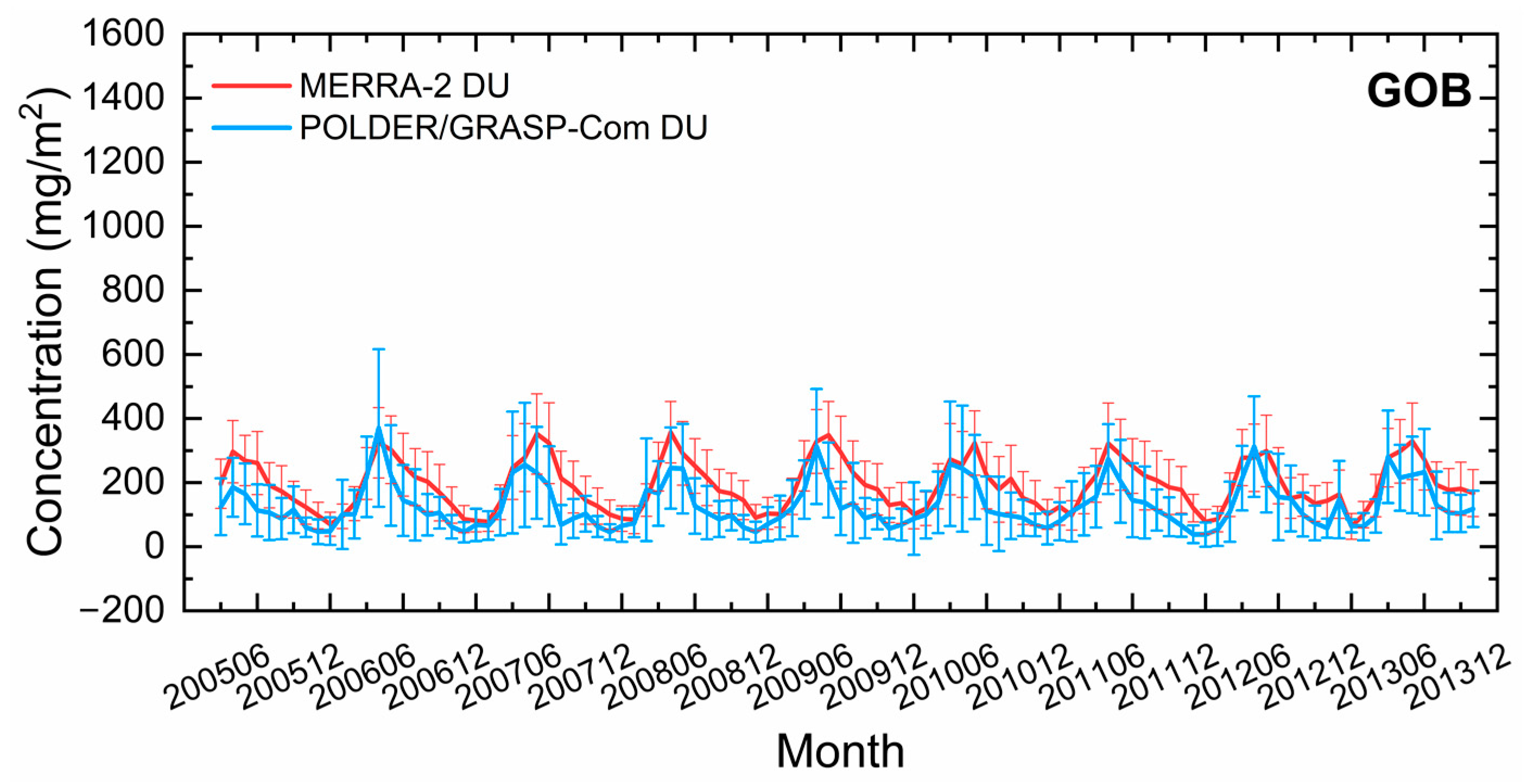
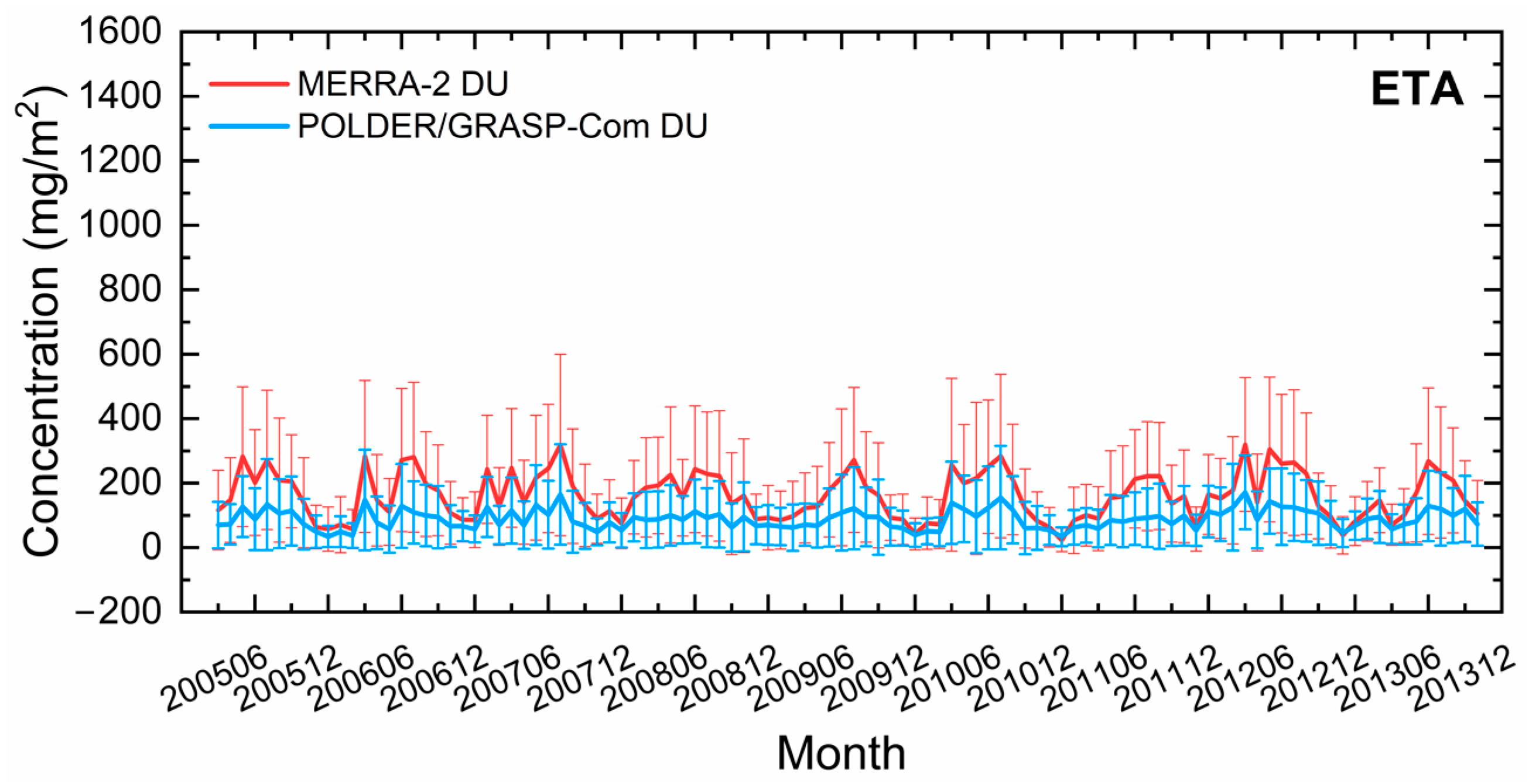
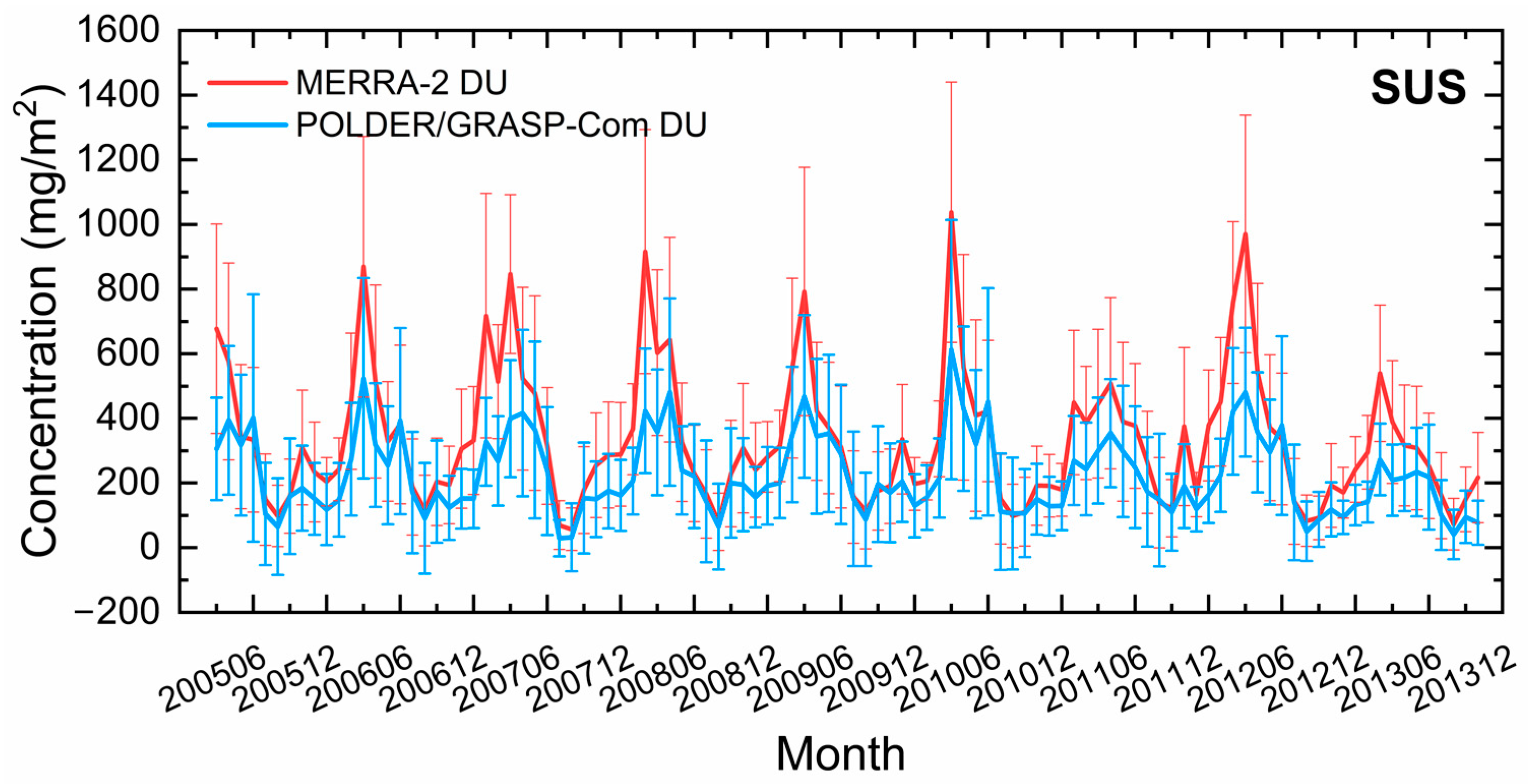

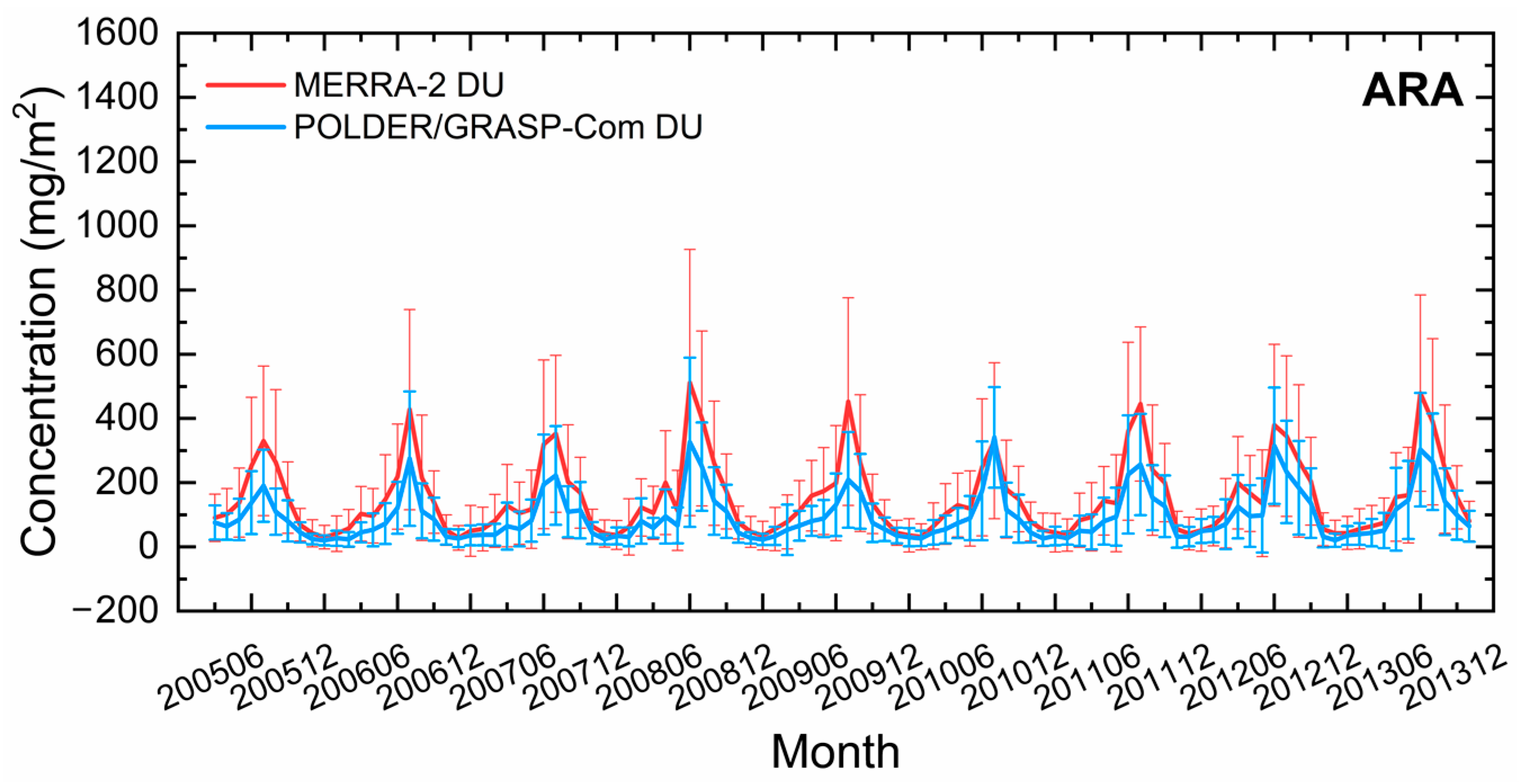
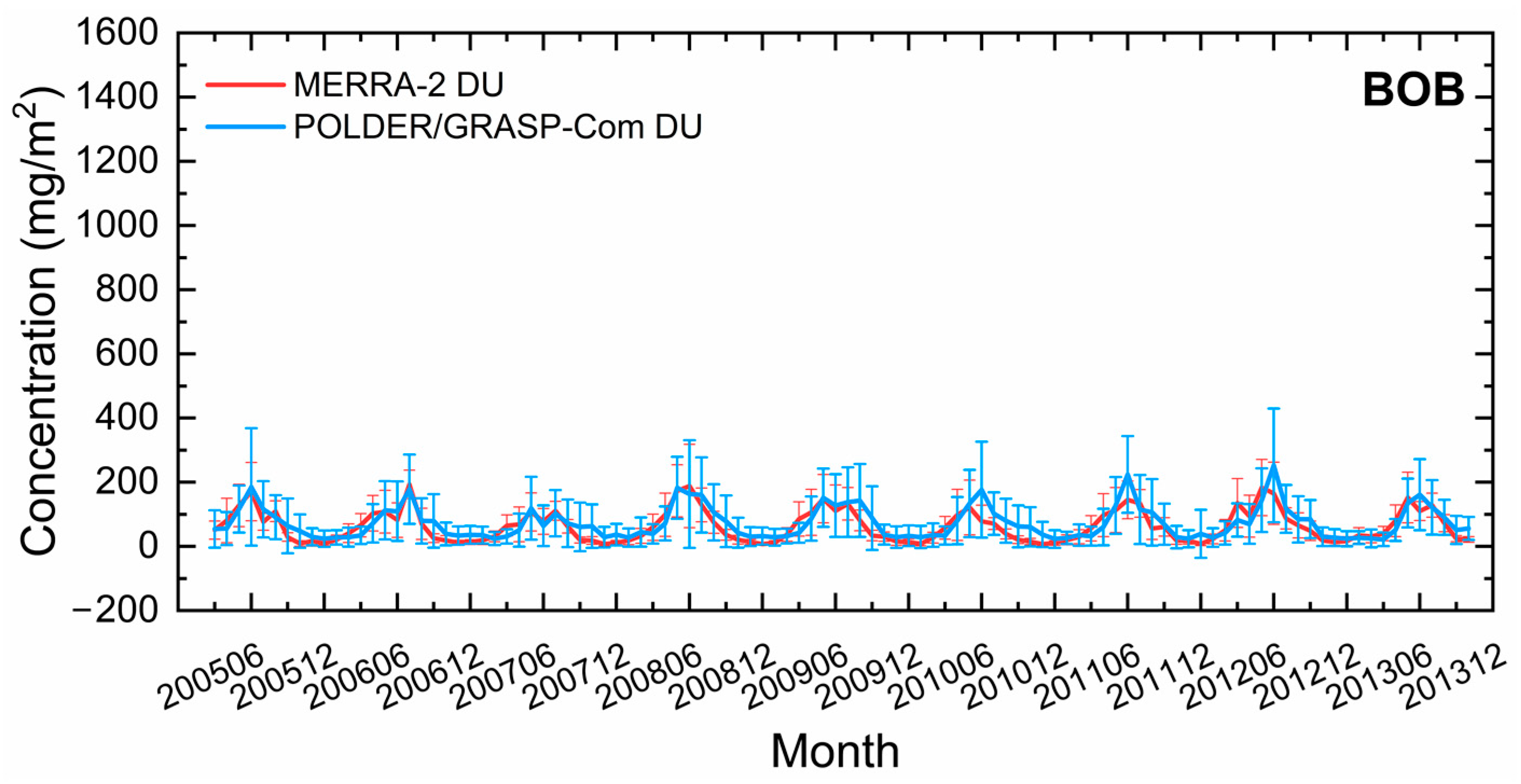
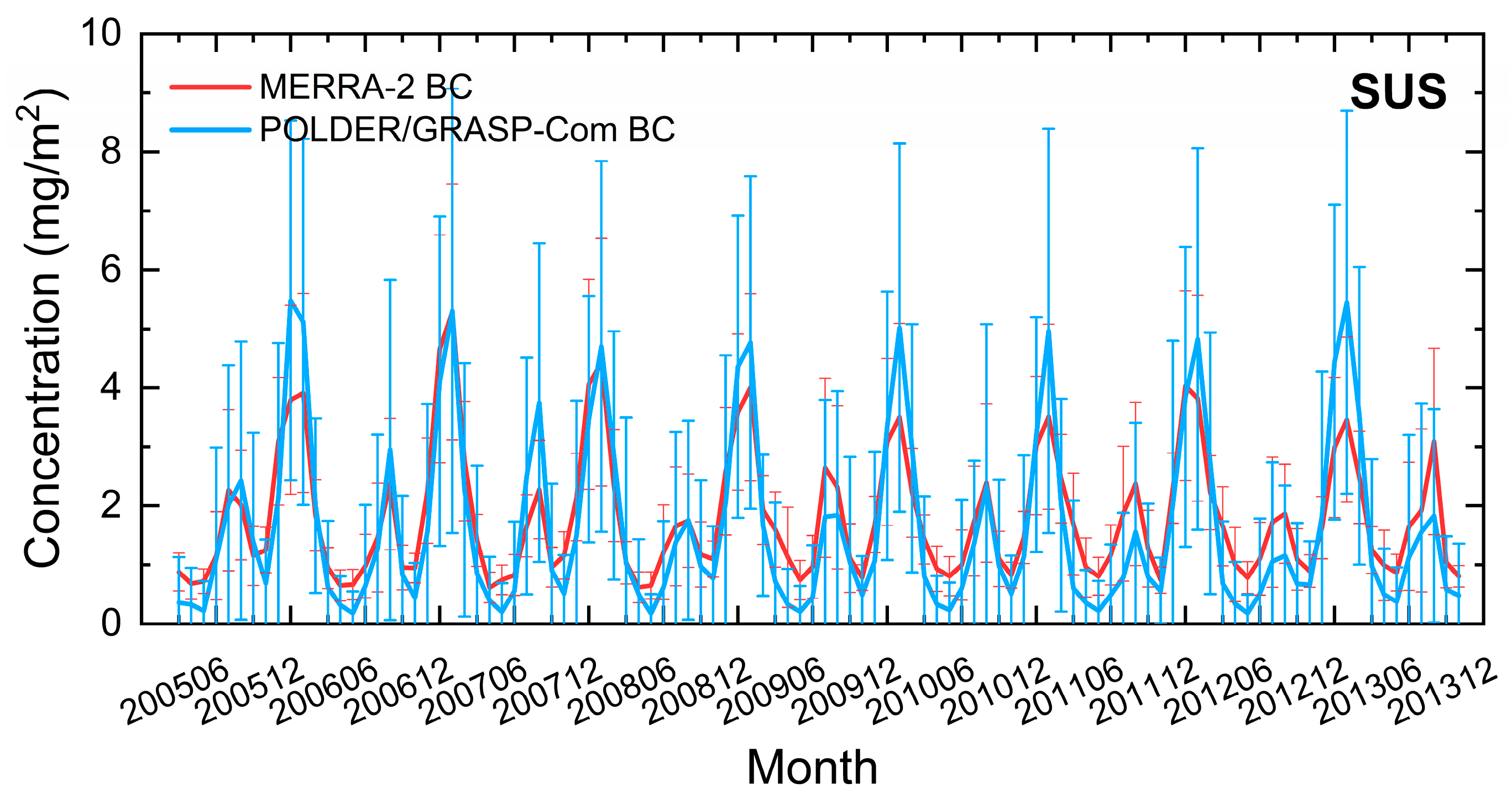
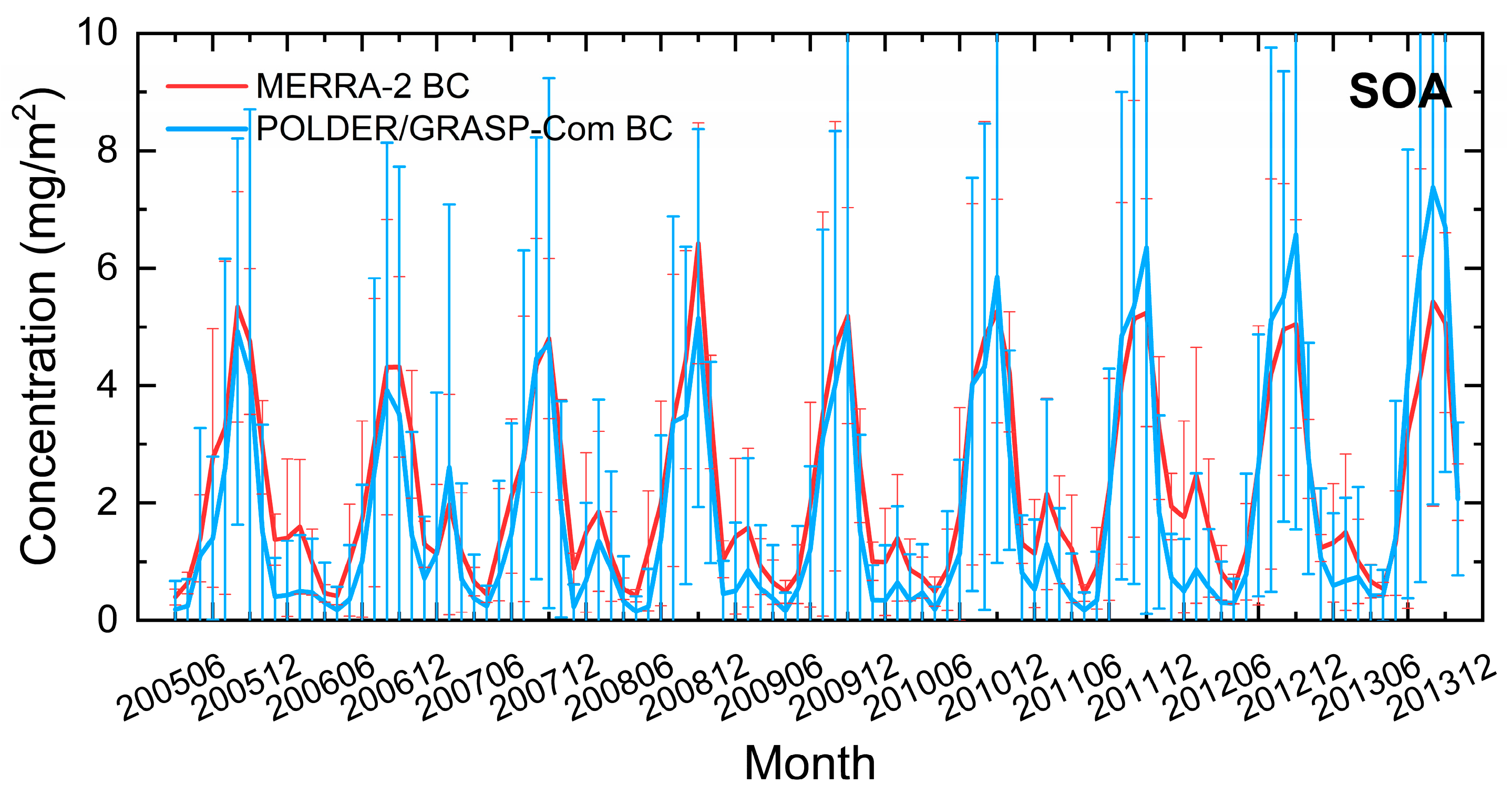
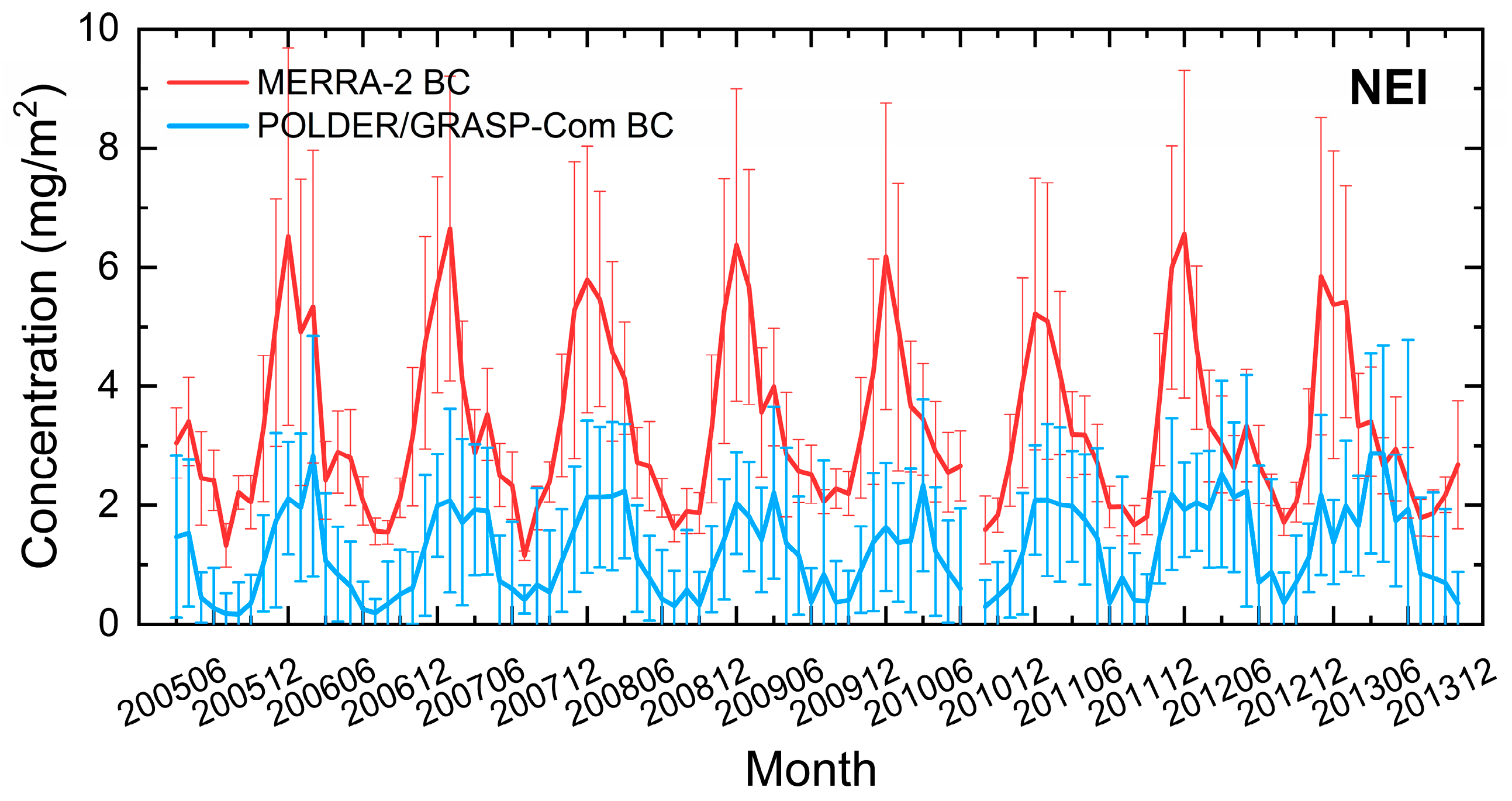
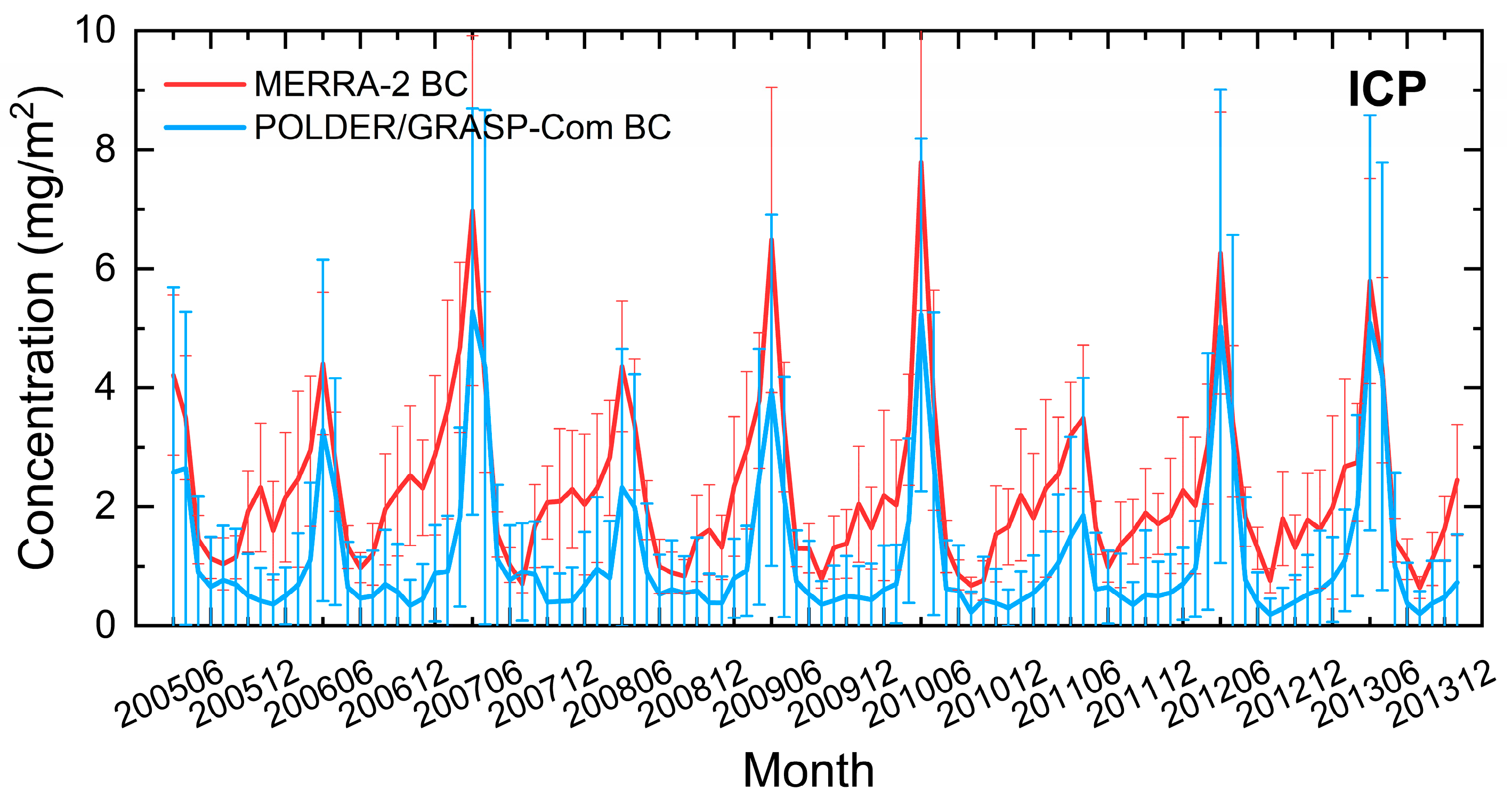

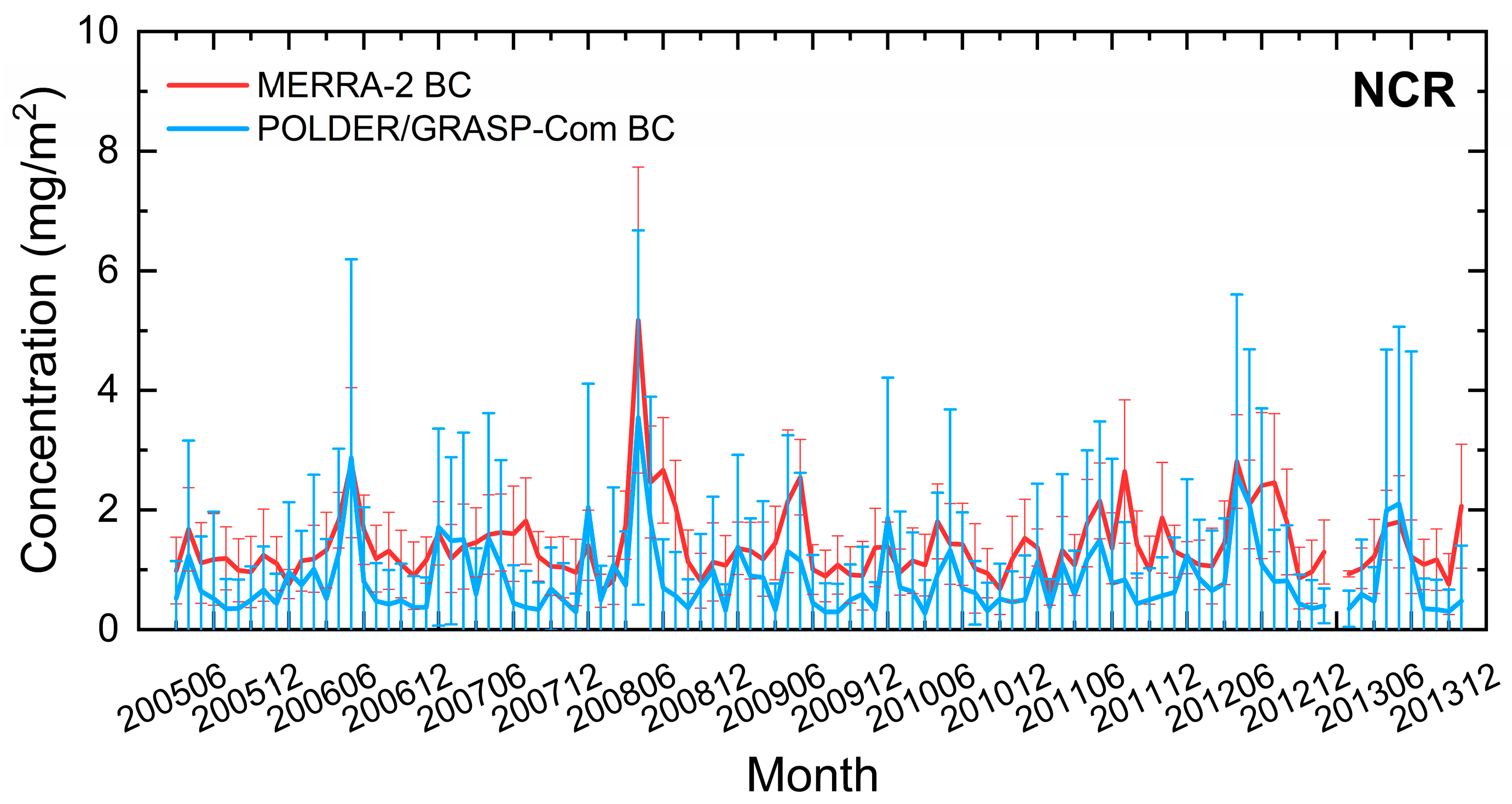
| Regions | Abbreviation | Latitude (°) | Longitude (°) |
|---|---|---|---|
| Desert areas | |||
| Sahara Desert | SAH | 18°N~30°N | 15°W~30°E |
| Bodélé Depression | BOD | 13°N~16°N | 12°E~18°E |
| Middle East | MIE | 10°N~35°N | 35°E~50°E |
| Taklamakan Desert | TAK | 35°N~45°N | 75°E~90°E |
| Gobi Desert | GOB | 37°N~45°N | 90°E~110°E |
| Downwind dust areas | |||
| Eastern Tropical Atlantic | ETA | 0~30°N | 16°W~45°W |
| Sub-Sahel | SUS | 0~13°N | 15°W~20°E |
| Mediterranean Basin | MED | 30°N~45°N | 5°W~35°E |
| Arabian Sea | ARA | 0~20°N | 50°E~70°E |
| Bay of Bengal | BOB | 5°N~22°N | 80°E~95°E |
| BC regions | |||
| Sub-Sahel | SUS | 0~13°N | 15°W~20°E |
| Southern Africa | SOA | 0~25°S | 15°E~35°E |
| Northeast India | NEI | 20°N~28°N | 80°E~88°E |
| Indo–China Peninsula | ICP | 15°N~25°N | 90°E~110°E |
| North China Plain | NCP | 30°N~40°N | 112°E~120°E |
| Northeast China and East Russia | NCR | 42°N~60°N | 120°E~140°E |
| Desert Region | R | RMSE (mg/m2) | Downwind Dust Region | R | RMSE (mg/m2) |
|---|---|---|---|---|---|
| SAH | 0.91 | 237.67 | ETA | 0.92 | 86.79 |
| BOD | 0.88 | 412.36 | SUS | 0.89 | 159.08 |
| MIE | 0.90 | 134.43 | MED | 0.88 | 82.34 |
| TAK | 0.80 | 122.30 | ARA | 0.98 | 89.48 |
| GOB | 0.84 | 74.36 | BOB | 0.84 | 29.61 |
| Month | SAH Diff. | BOD Diff. | MIE Diff. | TAK Diff. | GOB Diff. | |||||
|---|---|---|---|---|---|---|---|---|---|---|
| mg/m2 | % | mg/m2 | % | mg/m2 | % | mg/m2 | % | mg/m2 | % | |
| Jan. | 116.4 | 51.0 | 352.5 | 52.9 | 73.5 | 39.4 | −6.8 | −4.8 | 13.1 | 13.8 |
| Feb. | 122.8 | 40.6 | 369.2 | 47.0 | 54.0 | 19.4 | 7.9 | 3.2 | 34.8 | 22.1 |
| Mar. | 222.0 | 48.3 | 399.8 | 40.0 | 100.5 | 27.7 | −56.3 | −13.4 | 44.1 | 17.9 |
| Apr. | 256.8 | 42.3 | 379.6 | 34.3 | 88.6 | 20.6 | −60.5 | −11.3 | 35.9 | 11.8 |
| May | 305.9 | 43.4 | 479.1 | 44.7 | 90.7 | 18.0 | 53.6 | 9.4 | 98.3 | 31.6 |
| Jun. | 328.4 | 45.5 | 424.5 | 42.7 | 170.9 | 28.5 | 124.5 | 23.7 | 113.0 | 43.2 |
| Jul. | 289.7 | 42.9 | 470.8 | 54.2 | 189.3 | 33.1 | 24.7 | 7.0 | 82.9 | 41.1 |
| Aug. | 242.6 | 39.2 | 330.3 | 51.9 | 209.7 | 45.8 | 144.7 | 32.4 | 90.7 | 48.5 |
| Sep. | 211.1 | 40.5 | 302.2 | 49.0 | 117.8 | 33.7 | 141.7 | 35.8 | 63.9 | 39.4 |
| Oct. | 222.2 | 54.3 | 463.5 | 61.1 | 115.2 | 44.5 | 126.3 | 49.2 | 74.1 | 52.1 |
| Nov. | 159.8 | 62.8 | 428.9 | 67.7 | 101.0 | 55.9 | 55.3 | 35.3 | 49.9 | 44.6 |
| Dec. | 130.1 | 60.9 | 390.7 | 63.1 | 68.8 | 43.0 | 38.8 | 31.3 | 23.5 | 26.4 |
| Jan. | 42.5 | 34.7 | 171.1 | 45.0 | 29.7 | 41.4 | 15.4 | 30.8 | −9.2 | −47.3 |
| Feb. | 46.6 | 38.6 | 248.8 | 44.6 | 43.5 | 38.3 | 30.9 | 37.9 | 1.6 | 4.7 |
| Mar. | 87.0 | 46.1 | 330.3 | 44.8 | 112.4 | 60.0 | 46.2 | 41.4 | 27.2 | 39.8 |
| Apr. | 70.0 | 45.7 | 143.5 | 28.1 | 131.5 | 55.5 | 59.4 | 42.8 | 25.4 | 27.7 |
| May | 99.4 | 49.9 | 71.8 | 19.5 | 109.4 | 49.5 | 49.4 | 35.1 | 1.4 | 1.0 |
| Jun. | 129.3 | 53.6 | 13.5 | 4.1 | 94.7 | 50.7 | 155.6 | 42.1 | −37.1 | −29.6 |
| Jul. | 140.0 | 53.1 | 36.1 | 22.4 | 69.8 | 45.7 | 186.8 | 42.8 | −9.8 | −8.3 |
| Aug. | 107.2 | 51.4 | 19.0 | 20.0 | 60.9 | 46.0 | 109.2 | 44.2 | −24.6 | −35.1 |
| Sep. | 61.3 | 41.0 | 15.5 | 9.8 | 56.5 | 40.7 | 66.0 | 39.3 | −37.7 | −114.2 |
| Oct. | 41.7 | 36.3 | 97.3 | 39.2 | 65.5 | 55.1 | 25.2 | 36.7 | −26.0 | −137.6 |
| Nov. | 15.3 | 20.5 | 93.7 | 38.9 | 45.2 | 53.5 | 15.4 | 36.2 | −17.0 | −133.0 |
| Dec. | 19.5 | 25.0 | 115.6 | 44.0 | 31.6 | 47.0 | 9.2 | 21.8 | −19.7 | −177.8 |
| BC Region | R | RMSE (mg/m2) | BC Region | R | RMSE (mg/m2) |
|---|---|---|---|---|---|
| SUS | 0.92 | 0.66 | ICP | 0.89 | 1.30 |
| SOA | 0.94 | 0.77 | NCP | 0.46 | 3.88 |
| NEI | 0.72 | 2.31 | NCR | 0.68 | 0.75 |
| Month | SUS Diff. | SOA Diff. | NEI Diff. | ICP Diff. | NCP Diff. | NCR Diff. | ||||||
|---|---|---|---|---|---|---|---|---|---|---|---|---|
| mg/m2 | % | mg/m2 | % | mg/m2 | % | mg/m2 | % | mg/m2 | % | mg/m2 | % | |
| Jan. | −1.0 | −25.7 | 0.7 | 39.5 | 3.2 | 60.4 | 1.7 | 65.7 | 4.5 | 74.0 | 0.2 | 25.2 |
| Feb. | −0.2 | −9.8 | 0.5 | 46.4 | 2.7 | 67.3 | 1.5 | 47.7 | 4.5 | 77.0 | 0.2 | 18.5 |
| Mar. | 0.6 | 44.2 | 0.3 | 49.0 | 2.5 | 75.3 | 1.7 | 30.7 | 4.0 | 79.6 | 0.8 | 59.2 |
| Apr. | 0.5 | 55.3 | 0.3 | 53.3 | 2.3 | 76.2 | 0.7 | 21.0 | 4.0 | 84.7 | 0.6 | 24.4 |
| May | 0.5 | 70.5 | 0.4 | 38.4 | 2.0 | 73.4 | 0.7 | 47.0 | 3.5 | 73.2 | 0.4 | 19.1 |
| Jun. | 0.4 | 39.2 | 0.4 | 19.1 | 1.9 | 78.8 | 0.5 | 48.7 | 1.7 | 31.3 | 0.9 | 54.1 |
| Jul. | 0.4 | 18.6 | −0.2 | −6.5 | 1.4 | 84.3 | 0.4 | 47.1 | 3.7 | 80.4 | 1.1 | 67.4 |
| Aug. | 0.1 | 4.1 | 0.0 | 0.2 | 1.5 | 81.6 | 0.8 | 61.6 | 3.7 | 86.4 | 0.8 | 66.9 |
| Sep. | 0.2 | 17.1 | −0.2 | −4.4 | 1.7 | 83.5 | 1.2 | 71.8 | 3.6 | 78.7 | 0.4 | 43.3 |
| Oct. | 0.4 | 39.8 | 1.0 | 32.5 | 2.1 | 66.4 | 1.6 | 77.4 | 4.2 | 74.9 | 0.7 | 56.0 |
| Nov. | 0.5 | 22.3 | 0.7 | 52.8 | 2.9 | 58.1 | 1.4 | 75.5 | 4.3 | 79.8 | 0.8 | 66.5 |
| Dec. | −0.4 | −10.3 | 0.7 | 55.8 | 3.5 | 58.0 | 1.5 | 68.9 | 3.9 | 73.3 | −0.2 | −13.6 |
Disclaimer/Publisher’s Note: The statements, opinions and data contained in all publications are solely those of the individual author(s) and contributor(s) and not of MDPI and/or the editor(s). MDPI and/or the editor(s) disclaim responsibility for any injury to people or property resulting from any ideas, methods, instructions or products referred to in the content. |
© 2023 by the authors. Licensee MDPI, Basel, Switzerland. This article is an open access article distributed under the terms and conditions of the Creative Commons Attribution (CC BY) license (https://creativecommons.org/licenses/by/4.0/).
Share and Cite
Li, L.; Che, H.; Su, X.; Zhang, X.; Gui, K.; Zheng, Y.; Zhao, H.; Zhao, H.; Liang, Y.; Lei, Y.; et al. Quantitative Evaluation of Dust and Black Carbon Column Concentration in the MERRA-2 Reanalysis Dataset Using Satellite-Based Component Retrievals. Remote Sens. 2023, 15, 388. https://doi.org/10.3390/rs15020388
Li L, Che H, Su X, Zhang X, Gui K, Zheng Y, Zhao H, Zhao H, Liang Y, Lei Y, et al. Quantitative Evaluation of Dust and Black Carbon Column Concentration in the MERRA-2 Reanalysis Dataset Using Satellite-Based Component Retrievals. Remote Sensing. 2023; 15(2):388. https://doi.org/10.3390/rs15020388
Chicago/Turabian StyleLi, Lei, Huizheng Che, Xin Su, Xindan Zhang, Ke Gui, Yu Zheng, Hujia Zhao, Hengheng Zhao, Yuanxin Liang, Yadong Lei, and et al. 2023. "Quantitative Evaluation of Dust and Black Carbon Column Concentration in the MERRA-2 Reanalysis Dataset Using Satellite-Based Component Retrievals" Remote Sensing 15, no. 2: 388. https://doi.org/10.3390/rs15020388
APA StyleLi, L., Che, H., Su, X., Zhang, X., Gui, K., Zheng, Y., Zhao, H., Zhao, H., Liang, Y., Lei, Y., Zhang, L., Zhong, J., Wang, Z., & Zhang, X. (2023). Quantitative Evaluation of Dust and Black Carbon Column Concentration in the MERRA-2 Reanalysis Dataset Using Satellite-Based Component Retrievals. Remote Sensing, 15(2), 388. https://doi.org/10.3390/rs15020388








